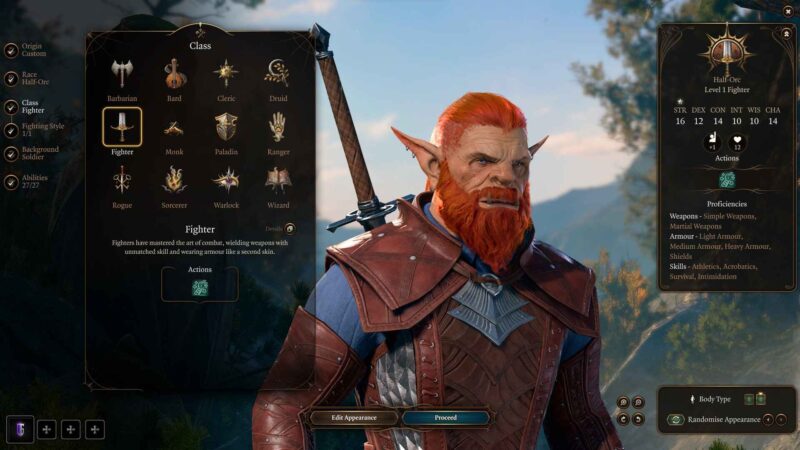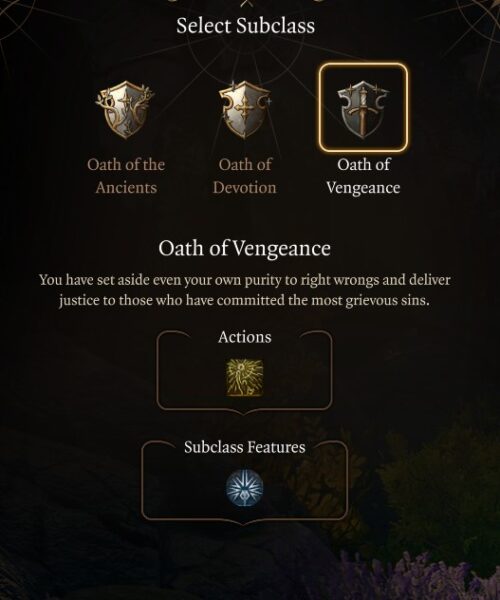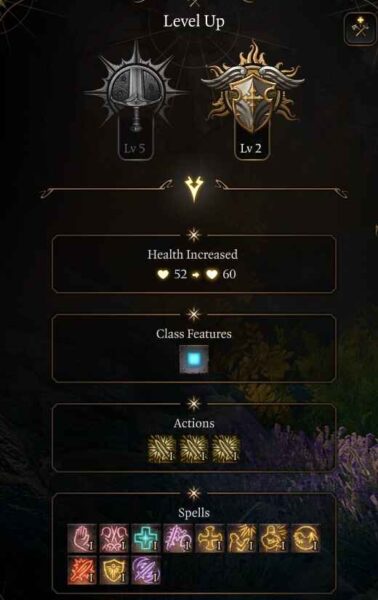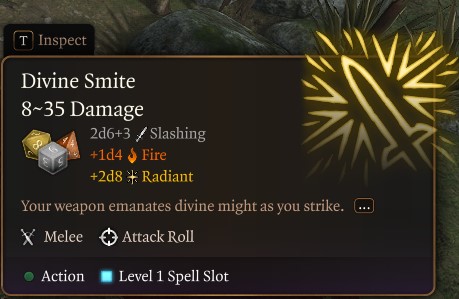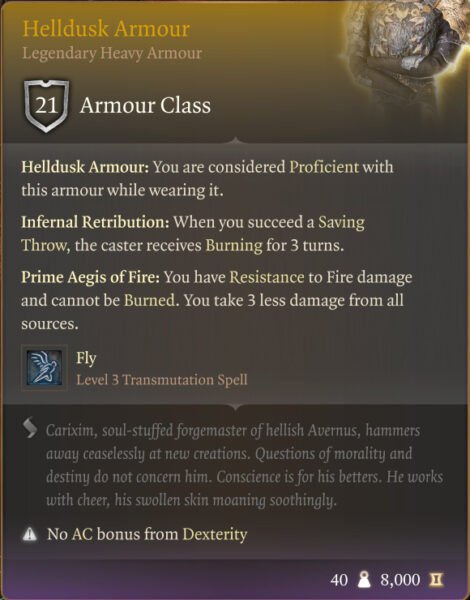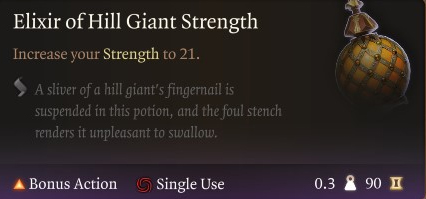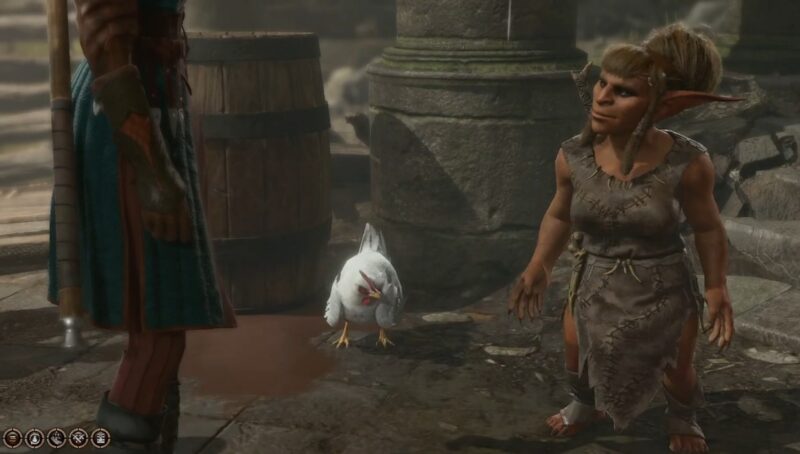This Multiclass guide focuses on the Multiclass Fighter in Baldur’s Gate 3, combined with the Fighter class, to create a powerful build.

This build page has been updated for the Patch 8 version of Baldur’s Gate 3.
Multiclass Fighter Build Guide
The Fighter class in Baldur’s Gate 3 is a powerful and versatile class that excels in all aspects of combat, but you can increase their potential even more by combining them with the Paladin class. Consider the multiclassed Fighter as a heavy armour, melee-focused damage dealer. Furthermore, this build will provide some of the highest single-target damage in BG3, and using both the Paladin and Fighter will create a fun and unique Fighter playstyle.
Fighters are proficient in all types of armor and weapons, and they have several abilities that allow them to deal damage, protect themselves, and control the battlefield. The Fighter’s most iconic ability is Action Surge, which allows them to take extra action on their turn. This in combination with Extra Attack allows the Fighter to take multiple actions and attack per turn making it one of the strongest combatants on the battlefield. Consider this build an easy-to-use, powerful, front-line damage dealer wielding a two-handed Greatsword with heavy armour.
Multiclass Fighter Build Changes in Patch 8 for BG3

The most significant change affecting character builds in Patch 8 of Baldur’s Gate 3 is the introduction of 12 new subclasses, each bringing unique strengths and weaknesses. Notably, the Eldritch Knight Fighter sees a major boost in power with the inclusion of the Booming Blade cantrip. This spell enhances each of the Fighter’s actions with additional thunder damage, resulting in a noticeable overall increase in damage output.
Significantly, multiclassing the Fighter with Warlock is now as viable (or arguably even better) than the Fighter/Paladin combination. Therefore, we’ll leave our original build of Battle Master Fighter and Oath of Vengeance Paladin in place, for those that appreciate that playstyle.
However, consider the Eldritch Knight if you want extra spellcasting utility. You can now use 11 levels of Fighter and 1 Warlock to gain even more spellcasting potential. This gives you extra utility and control when playing solo, while only sacrifcing one feat. Additionally, one level of Hexblade Warlock adds a lot of utility with the same premise of losing one feat. To demonstrate the viability of this, we’ve provided an alternative build below.
Multiclass Fighter Build Features
The following list presents all the essential Multiclass Fighter Build Mechanics and Features in Baldur’s Gate 3:
- Primary Ability: Strength
- Saving Throws: Strength and Constitution
- Armour Proficiency: Light Armour, Medium Armour, Heavy Armor, Shields
- Weapon Proficiency: Simple Weapon, Martial Weapons
- Defence Fighting Style: While you are wearing armor, you gain a +1 bonus to AC.
- Second Wind: Heal yourself with a bonus action.
- Action Surge: Gain one additional action, acquired at level 2.
- Extra Attack: You can make an additional free attack after making an unarmed or weapon attack.
- Battle Master Subclass: Gain four Superiority Dice, which are d8s, obtained at level 3.
- Divine Smite: Spend spell slots to deal additional radiant damage on a successful melee attack.
- Oath of Vengeance Subclass: subclass focused on damage and mobility.
- Inquisitor’s Might: You or an ally’s weapon attacks deal an additional 2 Radiant damage and can Daze enemies for one turn.
- Divine Smite: deals additional 2d8 Radiant damage on weapon damage.
- Gain Divine Health: prevents the disease from affecting you (passive benefit).
Multiclassing Explained
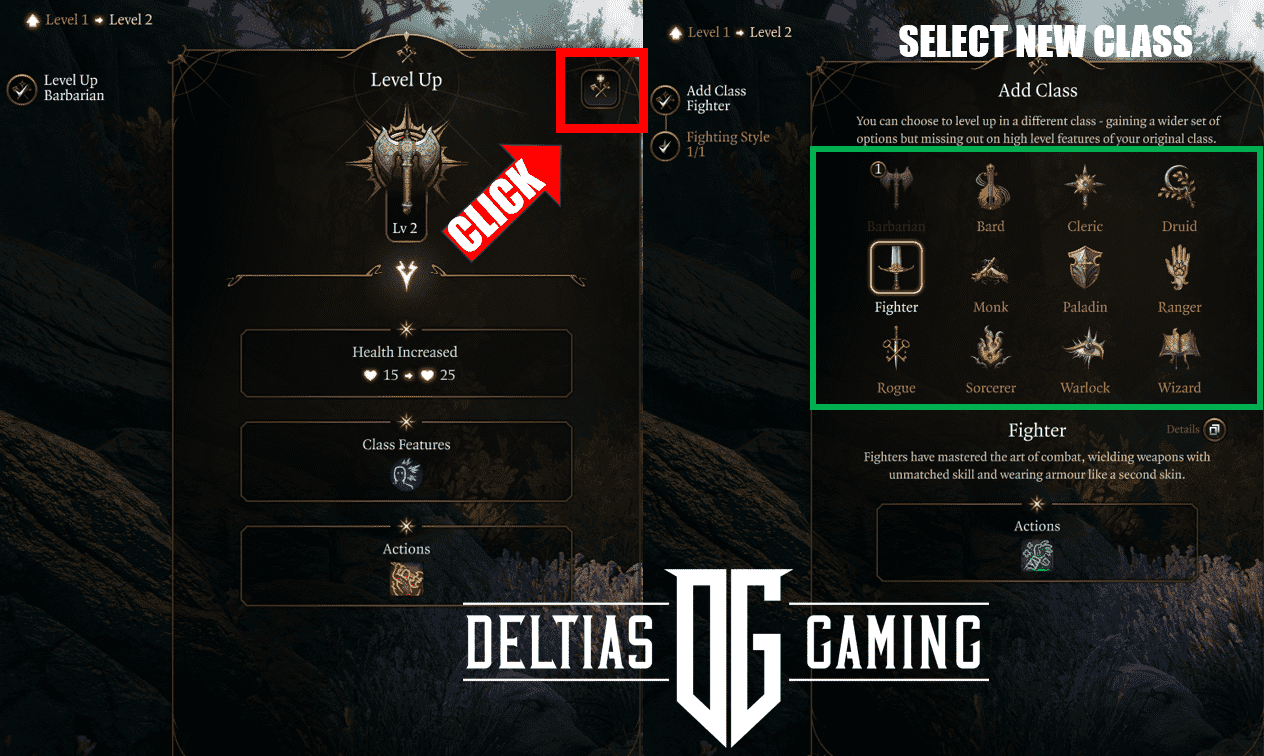
Multiclassing in Baldur’s Gate 3 allows your character to gain a level in a new class instead of advancing in their current class. To Multiclass in BG3, hit the top right plus button to add a class, so that it will bring up a new screen with the other classes in Baldur’s Gate 3.
Multiclassing grants most of the benefits of that new class, but there are some limitations. Your multiclassing character does not receive all the proficiencies of their new class. You also cannot multiclass when playing on Explorer Difficult.
Below is a list of Multiclass Proficiencies gained by taking one level in a new class:
| Class | Gained Proficiency |
|---|---|
| Barbarian | Shields, Simple Weapons, Martial Weapons |
| Bard | Light Armor, One skill, One instrument |
| Cleric | Light Armor, Medium Armor, Shields, Morningstars |
| Druid | Light Armor, Medium Armor, Shields |
| Fighter | Light Armor, Medium Armor, Shields, Simple Weapons, Martial Weapons |
| Monk | Simple Weapons, Shortswords |
| Paladin | Light Armor, Medium Armor, Shields, Simple Weapons, Martial Weapons |
| Ranger | Light Armor, Medium Armor, Shields, Simple Weapons, Martial Weapons, One skill |
| Rogue | Light Armor, One skill |
| Sorcerer | – |
| Warlock | Light armor, Simple Weapons |
| Wizard | – |
Best Fighter Multiclass
The best class for the Fighter to multiclass into is the Paladin because you can get the Divine Smite, Fighting Style, and Spellcasting. Also, a secondary multiclass choice for Fighter is the Barbarian for Rage, Reckless Attack, and Unarmoured Defence.
Here is the best multiclass choice for a Fighter build in Baldur’s Gate 3:
| Paladin | Barbarian |
|---|---|
| Spellcasting | Rage |
| Fighting Style | Reckless Attack |
| Divine Smite | Unarmoured Defence |
For this build, we recommend 8 levels of investment into the Fighter class and 4 levels into the Paladin. This will give you Action Surge, Extra Attack, 3 feats, Divine Smite, Spellcasting, and 2 Fighting Styles. The Vengeance Paladin Subclass will aid in bonus action utility and healing, while the Battle Master Fighter subclass helps with crowd control and combat dynamics. Combine these two for ultra-high damage, survivability, and a fun gameplay style with a lot more flash than your standard Fighter build.
Character Creation
| Category | Selection |
|---|---|
| Character | Origin – Custom character |
| Race | Half-Orc |
| Racial Bonus | Relentless Endurance, Darkvision, and Menacing |
| Class | Fighter/Paladin |
| Subclass | Battle Master/Oath of Vengeance |
| Background | Soldier |
| Ability Score | STR: 16 DEX: 12 CON: 14 INT: 10 WIS: 10 CHA: 14 |
| Skill Proficiencies | Acrobatics and Survival |
Best Race for the Multiclass Fighter
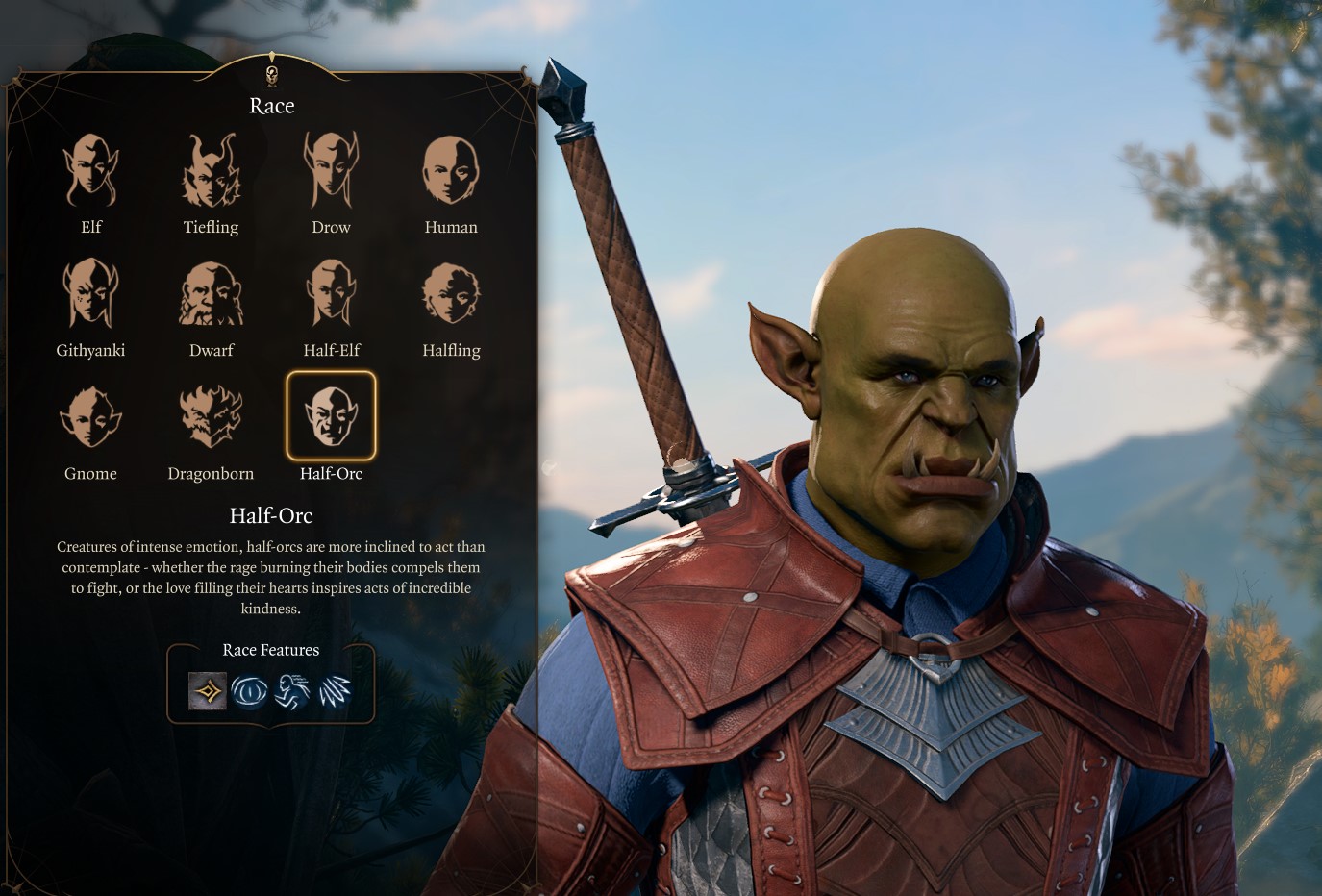
Half-Orc is the Best Race Choice for a multiclass Fighter because you gain Savage attack, rolling an additional damage dice on critical hits. The Half-Orc also gains Relentless Endurance, Darkvision, and Menacing giving you a balanced racial choice for damage and survivability. However, a secondary choice is the Zariel Tiefling for fire resistance, two Smite spells, and Darkvision.
Here is the best race choice for a multiclass Fighter build in Baldur’s Gate 3:
Best Background for the Multiclass Fighter

The best Background for a Fighter is a Soldier because has proficiency in Athletics and Intimidation. Backgrounds in Baldur’s Gate 3 are a way to represent your character’s backstory and give them some starting skills and abilities.
Best Ability Score for the Multiclass Fighter

The Best Ability Score for a multiclass Fighter Build is 16 Strength, 14 Constitution, and 14 Charisma. This will give your Fighter, Paladin multiclass Build great damage with weapon attacks, spell utility, and a good amount of hit points.
Below is the best ability score for a multiclass Fighter in Baldur’s Gate 3:
- Strength – 16
- Dexterity – 12
- Constitution – 14
- Intelligence – 10
- Wisdom – 10
- Charisma – 14
Best Skills for the Multiclass Fighter
Acrobatics and Survival are the best skills for the multiclass Fighter because they complement your build when exploring the environment.
Best Companions for the Multiclass Fighter
The best companions for a Fighter multiclass build in BG3 are Shadowheart, Gale, and Astarion. This will give you a balanced team with a Cleric for support, a Wizard for area damage, and a Rogue for ranged damage and utility.
- Shadowheart (Cleric): buffs, healing, and crowd control.
- Gale (Wizard): range magic damage, area damage, and crowd control.
- Astarion (Rogue): burst damage, lockpicking, and range if needed.
Related:
Multiclass Fighter Build – Level Progression in Baldur’s Gate 3
| Level | Class | Selection |
|---|---|---|
| 1 | Fighter | Great Weapon Fighting, Second Wind |
| 2 | Fighter | Action Surge |
| 3 | Fighter | Subclass: Battle Master, Disarming Attack, Trip Attack, Riposte |
| 4 | Fighter | Feat: Great Weapon Master |
| 5 | Fighter | Extra Attack |
| 6 | Paladin | Subclass: Oath of Vengeance, Lay on Hands, Divine Sense, Inquisitor’s Might |
| 7 | Paladin | Defence Fighting Style, Divine Smite, Shield of Faith, Divine Favour, Command, Thunderous Smite |
| 8 | Paladin | Bane, Hunter’s Mark, Abjure Enemy, Vow of Enmity, Searing Smite |
| 9 | Paladin | Feat: Ability Improvement Strength, Compelled Duel |
| 10 | Fighter | Feat: Ability Improvement Strength |
| 11 | Fighter | Pushing Attack, Precision Attack |
| 12 | Fighter | Feat: Savage Attacker |
Alternative Multiclass Fighter Build – Spellcaster Playstyle
For Fighter builds seeking increased spellcasting versatility and damage output, consider taking a one-level dip into Warlock with the Hexblade subclass at Level 12. This dip provides valuable bonus action utility, access to two strong spells, and a potent ranged cantrip. While Warlock is a Charisma-based class, the benefits it offers significantly enhance a Fighter’s toolkit, at the cost of just one feat. You can still comfortably hit 20 Strength and take Great Weapon Master with your available feats. Furthermore, if you start with 17 Strength during character creation and plan to earn Auntie Ethel’s bonus in Act 1, you’ll have an optimal setup. This build gives you strong melee and ranged damage options along with added utility, making for a well-rounded and powerful Fighter.
| Level | Class | Selection |
|---|---|---|
| 1 | Fighter | Great Weapon Fighting |
| 2 | Fighter | – |
| 3 | Fighter | Subclass: Eldritch Knight, Booming Blade, Friends, Shield, Thunderwave, Longstrider |
| 4 | Fighter | Feat: +2 STR, Chromatic Orb |
| 5 | Fighter | – |
| 6 | Fighter | Feat: Great Weapon Master |
| 7 | Fighter | Darkness, Gust of Wind |
| 8 | Fighter | Feat: Savage Attacker, Misty Step |
| 9 | Fighter | – |
| 10 | Fighter | Firebolt, Protection from Good and Evil |
| 11 | Fighter | Scorching Ray |
| 12 | Warlock | Hexblade Subclass, Eldritch Blast, Toll of the Dead, Hexed, Hellish Rebuke |
Level 1
Follow our character creator to pick all correct background, race, skills, and ability scoring focusing on Strength, Constitution, and Charisma. For this build, we will initially use 5 levels of Fighter and order to obtain the Great Weapon Master feat at level 4, and Extra Attack at level 5. This will allow additional attacks with one action and an additional attack with a bonus action on a critical hit or enemy kill. Then, the build will transition into 4 levels of Paladin to unlock Divine Smite and spellcasting. Finally, you’ll come back to Fighter to finish off important feats and class features. The Fighter unlocks their subclass with 3 levels of investment and the Paladin unlocks there with 3 levels as well.
Your goal is to find some heavy armor and a two-handed weapon Greatsword ideally. The first option is Everburn Blade, the Sword of Justice, and Silver Sword all in Act 1. You can grab medium armor from Lae’zel in the introduction if you don’t plan on using her. Then look to access the Hollowed City at the north of the starting spot post tutorial where Dammon and others will sell good armor. Below we will walk you through the leveling progression when using the Best Baldur’s Gate 3 Multiclass Fighter Build.
Class Features
The Fighter at this level unlocks two features, Great Weapon Fighting and Second Wind. Great Weapon Fighting: When you roll a 1 or 2 on a damage die for an attack with a two-handed melee weapon, that die is rerolled once. This just helps us not fail on dice rolls and gives us more reason to use two-handed weapons.
Second Wind: You will receive a very powerful self-heal immediately called Second Wind. This allows you to heal yourself using a bonus action, not an action. This is very important because you can heal and attack in one turn. The gameplay at this level is simply attacking with a melee weapon and using the range attacks when you cannot close the distance. Use Second Wind when you need a heal and or a potion and rinse and repeat.
Multiclass Fighter Gameplay & Priorities
At the start of the game, you will feel weak until level 5 where you gain Extra Attack. Your priority for the solo Fighter build is locating heavy armour, a two-handed Greatsword, and a Longbow or Heavy Crossbow. Lae’zel, who you meet in the prologue has powerful medium armour with 15 AC along with a Heavy Crossbow. If you don’t plan on using this companion, take her gear immediately and equip her for a big boost in overall survivability and ranged damage.
From this point, you need to hoard potions, arrows, and consumable potions. The advantage of the Fighter is not needing constant long rest. Moreover, look to acquire Elixir of Hill Giant Strength, Potion of Speed, and Oil of Accuracy consumables. These three consumables “stack” allowing for massive damage overall! Your priority with this build is the following:
- Complete Prologue
- Recruit Companions
- Unlock Withers, respec companions to proper class/ability score
- Collect the Necromancy of Thay (important in Act 3)
- Reached Hollowed City/Druid Grove
- Sell, Stock up, complete quests
- Unlock summons, Scratch, Shovel
- Progress to level 5
- Reach Underdark and Grymforge
- Check all Permanent Bonuses in Act 1 and the best Gear
Following these steps ensures a strong foundation, especially if you plan on playing solo or on Honour Mode difficulty.
Level 2
Level 2 the Fighter gets a very powerful skill, Action Surge: gain one additional action. This allows the Fighter very early to take multiple actions, which will likely be weapon attacks. This makes you formidable very early in the game. Moreover, you only need a Short Rest to replenish this, which can be done twice in the bottom right of your User Interface.
You now have a way to get two attacks in one turn along with a self-heal. Play aggressively and charge in. Don’t forget to equip a bow because you want some type of range weapon when melee isn’t an option because of distance. What you lack at this level is crowd control and mobility. You can solve both of those through your subclass next level and gear.
Level 3
Level three you get access to your subclass and for this build, we want to select Battle Master: this will give you access to a new mechanic called Superiority Dice, which are d8s. Think of this as an additional resource that can be replenished during long rest. You will also get to select three maneuvers which are attacks that consume superiority dice. We suggest the following:
Maneuver Selections
- Disarming Attack: Spend a superiority die to make an attack that deals additional damage and possibly forces the target to drop the weapons they are holding. This essentially shuts down completely weapon-based damage dealer if you drop their weapon. You can use this at melee or at range and is super effective against Barbarians, Fighters, and Longbow users. You can disarm and even pick up the weapon immediately following preventing the enemy from using it. This doesn’t work on casters, but amazing skill for the entirety of the game.
- Trip Attack: Spend a superiority die to make an attack that deals an additional 1d8 damage and possibly knocks the target Prone. The target must be Large or smaller. This attack is used for a stun in melee or at range. Prone is a status effect and this can be used on casters or non-weapon-based enemies. With these two maneuvers, you will have battlefield control early instead of mindlessly swinging your two-handed weapon.
- Riposte: When a hostile creature misses you with a melee attack, expend a superiority die to retaliate with a powerful strike that deals an additional 1d8 damage. Your Fighter will most likely be taking a lot of damage, and if they miss this use a reaction (not an action) and do some free damage in return using your superiority dice resource. Don’t use the resource if you are low and need a stun next turn.

Multiclass Fighter Level 3 Gameplay
Gameplay on the Fighter at this level gives you two types of control disarm and stun. You can also use Pommel Strike on a Greatsword to proc Daze as well. Continue to use crowd control and weapon damage and use Action Surge when you need another attack. Short rest after every battle if possible to replenish your resources.
Level 4
At Level 4 you can take a feat and we recommend taking the Great Weapon Master: When a melee attack scores a critical hit or kills a creature, you can make another melee attack as a bonus action. When attacking with Heavy Weapons you are proficient with, attack rolls take a -5 penalty, but their damage increases by 10.
Great Weapon Master Explained
Great Weapon Master (GWM) is a massive boost to our kill potential and makes your bonus action much more valuable. When you kill an enemy or critically strike one, you then can use a free GWM attack with a bonus action. Next level you will get Extra Attack, which grants two attacks with one action improving the chances of triggering this effect and overall a big boost to your damage.
GWM has another component to it, which increases your damage but makes your attacks more difficult to hit. You can toggle this feature on or off. Depending on your Strength and other factors, this might be very low initially. If so, toggle it off until you increase your Strength or get a Cleric to cast the Bless spell. There are other powerful consumables below in the consumable sections that will help with the percentage of landing an attack and overall damage as well.
Look to move close to a weakened or near-dead target to take advantage of GWM. Movement will most likely be an issue because you will need high speed to traverse from one target to another. The Haste Helm and other early game sets that give you momentum (increase movement) are vital to ensuring you get the most out of each turn and don’t just shoot a heavy crossbow shot.
Level 5
Level 5 is where the Fighter starts to feel very powerful. You get Extra Attack, along with Action Surge AND Great Weapon Master. Extra Attack: Allows you to make two attacks when you take the Attack action on your turn. In one turn, you can attack twice with Extra Attack, kill an enemy or critical strike, and attack again with Great Weapon Master. You use Action Surge and attack another two times for a total of 5 in one turn. You can make it 7 by either using a Potion of Speed or having someone cast Haste on you. This gives you another action once per turn.
And this is why the Fighter is so strong, in an action meta game, nothing beats it. You need to use superiority dice and those attacks sparingly when the situation calls for it. Otherwise, just keep it simple and blast people with multiple attacks!
From this level, you have the foundation of a powerful Fighter Build. We are going to transition into four levels of Paladin to take advantage of all that class has to offer including Divine Smite and Spellcasting!
Level 6
At Level 6, select the + sign in the upper right of the leveling screen. Select the Paladin class and the Vengeance subclass. Below is what you unlock with 1 level into the Vengeance Paladin:
- Channeled Oath Charges: Paladin-specific resource that allows the casting of spells and abilities.
- Lay on Hands: Use your blessed touch to heal a creature or cure it of all diseases and poisons.
- Divine Sense: Gain Advantage on Attack Rolls against celestials, fiends, and undead.
- Oath of Vengeance Subclass: subclass focused on damage and mobility.
- Inquisitor’s Might: You or an ally’s weapon attacks deal an additional 2 Radiant damage and can Daze enemies for 1 turn.
- Oath of Vengeance Tenets: Fight the Greater Evil. Exerting your wisdom, identify the higher morality in any given instance, and fight for it—no Mercy for the Wicked.
The Vengeance subclass will help aid in single-target damage and provide additional spells. You must maintain your Oath, which is influenced by dialogue choices and behavior. In general, don’t go around murdering peasants and double-crossing allies. If you want to play as a murdering rampaging Fighter/Paladin, then use the Oathbreaker subclass. This will only change a few subclass features while maintaining the essential Paladin feel and this build outline. Read this guide on how to become or remove the Oathbreaker if this happens.
With one level into Paladin, you mainly unlock your resource, a useful heal Lay on Hands, and some buffs. The gameplay is mainly the same, except you have more utility.
Ending Act 1 as a Multiclass Fighter
Approaching Level 6, you should be close to transitioning out of Act 1. Be sure to visit traders and stock up on camp and alchemy supplies. Additionally, make sure to find the best Act 1 items. Furthermore, there are also permanent bonuses you should find in Act 1. Finally, the Grymforge has powerful armor and weapons (Adamantine) that can be used well into Act 3. Consider taking the time to collect the crafting items before moving on to Act 2, where you won’t be able to return.
Related:
Level 7
With two levels invested into Paladin, you unlock a lot of features including a Fighting Style and Divine Smite. Here’s what happens at this level:
- Defence Fighting Style: While you are wearing armor, you gain a +1 bonus to AC.
- Divine Smite (class feature): deals 2d8 Radiant weapon damage and consumes a spell slot.
- Shield of Faith: Surround a creature with a shimmering field of magic that increases its Armour Class by 2.
- Divine Favour: Your prayer empowers you with divine radiance. Your weapons deal an additional 1d4 Radiant damage.
- Command: Command a creature to flee, move closer, freeze, drop to the ground or drop its weapon.
- Thunderous Smite (spell selection): Your weapon rings with thunder as you strike, pushing your target 3m away and possibly knocking it Prone.
Divine Smite Explained
Divine Smite is a signature ability of the Paladin class in Baldur’s Gate 3. It allows Paladins to expend a spell slot to deal additional radiant damage to a creature they have hit with a melee weapon attack. The amount of extra damage is equal to 2d8 for a 1st-level spell slot, plus 1d8 for each spell level higher than 1st. The damage increases by 1d8 if the target is an undead or a fiend.
Divine Smite can be toggled on or off in the reactions menu under the user interface. This allows you to decide whether or not to use it on a given attack. This is important because Paladins can quickly run out of spell slots, limiting their damage output. You don’t want to waste a spell slot on a weak creature. Divine Smite isn’t considered a spell and doesn’t require concentration. It simply adds damage via spell slot resources. This will boost your damage, and you can now still use two attacks with Fighter and Extra Attack.
Fighting Style Explained
The Fighting Style selection assumes you will follow the two-handed weapon and heavy armor gameplay. Defence style increases your AC by +1 passively helping you avoid including attacks. In terms of spells, use sparingly as your spell slots should go to Divine Smite. The command spell is a powerful stun similar to Battle Master Manevours. Thunderous Smite is costly because it consumes action and a bonus action, but has some utility when you need damage and a chance at a stun. Divine Favour is a way to deal a little more radiant damage per turn but consumes a spell slot as well.
Our suggestion is to add some Divine Smite damage to your Fighter gameplay. The Battle Master Disarming and Trip attacks alongside Divine Smite give you great crowd control and even more bursts. Expect to long rest a lot more frequently until you increase your spell slots and use them sparingly.
Multiclass Fighter Level 7 Spells: Shield of Faith, Divine Favour, Command, and Thunderous Smite.
Level 8
Putting another level into the Paladin unlocks two subclass spells, two subclass actions, and a newly prepared spell.
- Bane (subclass spell): Up to 3 creatures receive a -1d4 penalty to Attack Rolls and Saving Throws.
- Hunter’s Mark (subclass spell): Mark a creature as your quarry to deal an additional 1d6 Slashing Damage whenever you hit it with a weapon attack. If the target dies before the spell ends, you can mark a new creature without expanding a spell Slot.
- Abjure Enemy (subclass ability): Frighten an enemy, they’ll be easier to hit and cannot move. Fiends and undead have Disadvantage on this Saving Throw.
- Vow of Enmity (subclass ability): Gain Advantage on Attack Rolls against an enemy.
- Divine Health (subclass feature): prevents the disease from affecting you.
- Searing Smite (spell selection): Your Weapon deals an extra 1d6 Fire damage and marks the target with Searing Smite. A target with Searing Smite takes 1d6 Fire damage every turn until it succeeds on a Constitution saving throw.
Abjure Enemy and Vow Enmity are not technically spells and consume your Channeled Oath resource, so consider them a utility skill. Bane and Hunter’s Mark are useful spells, but both require concentration, so they become less useful and typically are avoided. Divine Health is a passive feature and is helpful. Searing Smite is another Smite spell, and if you are a Zariel Tiefling, you can use one for free per long rest. The gameplay remains the same at this level, though it can be helpful to use Hunter’s Mark if you don’t have another use for your bonus action each turn. Typically Misty Step or Great Weapon Master proc or what consumes your bonus action.
Multiclass Fighter Level 8 Spells: Shield of Faith, Divine Favour, Command, Thunderous Smite, and Searing Smite.
Level 9
We are going to stay in Paladin for one more level to unlock a feat. Since we took Great Weapon Master first, we will increase our strength by +2. With another feat, the next level, we can increase to 20 which is the cap through ability improvements. Below are our recommendations at this level:
- Lay on Hands Charge (class action): Use your blessed touch to heal a creature or cure it of all diseases and poisons.
- Compelled Duel (spell selection): Compel an enemy to attack only you. It cannot attack other creatures.
- Ability Improvement (feat selection): +2 to the Strength ability score.
This concludes our Paladin levels. You added a lot more utility and burst potential and we will now swap back to the Fighter for the remainder of the leveling process.
Multiclass Fighter Level 9 Spells: Shield of Faith, Divine Favour, Command, Thunderous Smite, and Searing Smite.
Level 10
You want to swap back to Fighter at this level. The main reason is, that the Paladin gains Extra Attack at level 5 which is redundant with the Fighter. Moreover, you want to hit 8/4 to gain four feats. This allows you to get your strength to 20 with two feats for massive damage. So take Ability Improvement (feat selection): +2 to the Strength ability score. From here, we will gain some more utility with Manoeuvre’s next level and another feat.
Level 11
With 7 levels into the Fighter, the Battle Master Subclass unlocks two more Manoeuvres. We recommend taking Pushing Attack and Precision Attack.
- Pushing Attack: Spend a superiority die to make an attack that deals an additional 1d8 damage and possibly pushes the target back 4.5m.
- Precision Attack: You can spend a Superiority Die to add it to the result of an Attack Roll.
Pushing Attack is simply a knockback and is helpful to knock enemies off cliffs or off an ally who needs to retreat. Precision Attack simply consumes a Superiority Die and adds damage. This doesn’t cost an action or a bonus action, so it can be useful to add damage when you don’t need to stun or disarm an enemy and have 4 or so Superiority Dice.
Related:
Level 12
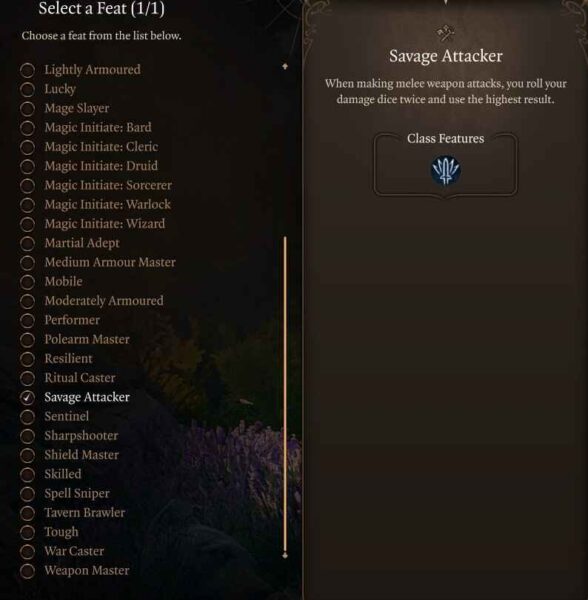
Congratulations on reaching the maximum level with the Best Baldur’s Gate 3 Multiclass Fighter Build! For this final level, you get another feat, which we suggest Savage Attacker: You roll your damage dice twice when making melee weapon attacks and use the highest result. This will help increase your damage even further and the combination of Extra Attack, Divine Smite, and Action Surge gives you massive burst potential. Make sure to check below in our recommended gear section for more details about this build.
Recommended Gear for Baldur’s Gate 3 Multiclass Fighter Build
In Games like Baldur’s Gate 3, you’ll explore the world, loot chests and your enemies’ dead bodies, and complete quests and all those activities can reward you with useful items, potions, armor, weapons, scrolls, and much more. There are three Acts in BG3, and Best Baldur’s Gate 3 Multiclass Fighter Build Guide includes suggested sets and alternatives for Act 1 and Act 3.
Beginner: Starting the Game
Here’s the best beginner gear for Multiclass Fighter Build in Baldur’s Gate 3:
| Gear Slot | Best Gear Item | Effect |
|---|---|---|
| Head | Haste Helm | Increase Movement |
| Cape | – | |
| Chest | Adamantine Splint Armour | 18 AC |
| Gloves | Gloves of the Growling Underdog | Advantage on Melee |
| Boots | Disintegrating Night Walkers | Free Misty Step |
| Necklace | Moondrop Pendant | No Opportunity Attacks |
| Ring | Crusher’s Ring | Increase Movement |
| Ring | Caustic Band | Poison Damage |
| Weapon 1 Main Hand | Everburn Blade | 2d6 Slashing |
| Weapon 2 Ranged | Titanstring Bow | Add STR modifier |
Below is a list of the best Act 1 equipment for the Multiclass Fighter in Baldur’s Gate 3:
- Haste Helm: Chest in the Blighted Village X 32, Y 403 (Alternative Grymskull Helm).
- Adamantine Splint Armour: Can be crafted at Grymforge (Alternative Chain Mail +1).
- Gloves of the Growling Underdog: Chest behind Razglin’s throne room. (X295 Y69) (Alternative Gloves of Dexterity).
- Disintegrating Night Walkers: Obtained in Gyrmforge as part of Free True Soul Nere questline (Alternative Boots of Speed).
- Moondrop Pendant: Sealed chest inside the Owlbear Nest (Alternatives Amulet of Branding, Amulet of Misty Step, or Amulet of Restoration).
- Crusher’s Ring: Can be looted or stolen from Crusher in the Goblin camp (Alternatives Strange Conduit Ring, or Ring of Absolute Force).
- Caustic Band: Obtained from merchant Derryth Bonecloak in the Myconid Colony (Alternatives Fetish of Callarduran Smoothhands, or The Sparkswall).
- Everburn Blade: Can be looted from Commander Zhalk during the prologue (Alternative Silver Sword of the Astral Plane or Sword of Justice).
- Titanstring Bow: Brem in Zhentarim Hideout (Alternatives Bow of Banshee, Bow of Awareness, or Giantbreaker).
Advanced: End-Game
The following table presents the best advanced and end-game gear for Multiclass Fighter Build in Baldur’s Gate 3:
| Gear Slot | Best Gear Item | Effect |
|---|---|---|
| Head | Helm of Balduran | Self-healing |
| Cape | Fleshmelter | Return Damage |
| Chest | Helldusk Armour | 21 Armour Class |
| Gloves | Gauntlets of Hill Giant Strength | 23 Strength |
| Boots | Helldusk Boots | Mobility |
| Necklace | Amulet of Greater Health | 23 Constitution |
| Ring | Killer’s Sweetheart | Auto Crit |
| Ring | Ring Of Regeneration | Self-healing |
| Weapon 1 Main Hand | Balduran’s Giantslayer | Best Greatsword |
| Weapon 2 Ranged | Gontr Mael | Best Longbow |
Below is a list of the best gear, weapons, and armor for the Multiclass Fighter build in Baldur’s Gate 3:
- Helm of Balduran: Obtained in Dragon’s Sanctum (Alternatives Helldusk Helmet, Sarevok’s Horned Helmet, or Mask of Soul Perception).
- Fleshmelter: Found in Chest in House of Healing Morgue (Alternative Cloak of Protection).
- Helldusk Armour: Dropped by Raphael in the House of Hope (Alternatives Armour of Devotion, Armour of Persistence, Bhaalist Armour).
- Gauntlets of Hill Giant Strength: Obtained in Archive of the House of Hope (Alternatives Helldusk Gloves, Legacy of the Masters, or Gloves of Soul Catching).
- Helldusk Boots: In a locked chest, Wyrm’s Rock Fortress X: -32 Y: 219 (Alternative Disintegrating Night Walkers).
- Amulet of Greater Health: Found in the House of Hope in Baldur’s Gate City (Alternatives Surgeon’s Subjugation Amulet, or Periapt of Wound Closure).
- Killer’s Sweetheart: Obtained from the Gauntlet of Shar in Act 2 (Alternative Ring of Protection, Risky Ring).
- Ring Of Regeneration: Sold by Rolan at Sorcerous Sundries (Alternative Ring of Free Action, Shifting Corpus Ring).
- Balduran’s Giantslayer: Obtained as a reward for completing the Wyrmway trials (Alternatives Sword of Chaos, or Silver Sword of the Astral Plane).
- Gontr Mael: Looted from the Steel Watcher Titan in Steel Watch Foundry (Alternatives Darkfire Shortbow, or Fabricated Arbalest).
Best Consumables, Potions, and Items
The following list represents the best individual use consumable items that will aid in our Best Baldur’s Gate 3 Multiclass Fighter Build Guide:
- Elixir of Bloodlust: Once per turn when you kill a foe, you gain HP 5 temporary hit points and an additional action.
- Elixir of Hill Giant Strength: Increases Strength ability score to 21 until Long Rest.
- Potion of Speed: Gain extra action, +2 AC, Advantage on Dexterity Saving Throws, and double movement speed.
- Drow Poison: Weapon poison that adds Constitution Saving Throw or becomes Poisoned and falls Asleep.
- Potion of Flying: Drink to gain a flying speed of 60ft for one hour.
- Elixir of Heroism: Gain 10 temp HP and become Blessed until a long rest.
- Potion of Greater Healing: 4d4 + 4 hit points restored.
- Oil of Accuracy: Coat Weapon. Bonus of +2 in Attack Rolls.
- Elixir of Vigilance: Drink to gain a +5 bonus to Initiative and you can’t be Surprised.
- Elixir of Darkvision: (only non-Darkvision race): Drink to gain the ability to see in the dark up to 12m.
Permanent Bonuses

Throughout Baldur’s Gate 3, you will have the ability to gain permanent bonuses to your character. These can grant additional spells, ability scores, and other bonuses. Permanent Bonuses are not displayed throughout the campaign but are vital to increase overall combat performance. We have all permanent bonuses here in a guide, but the most important ones for you to collect are listed below.
| Act 1 | Act 2 | Act 3 |
|---|---|---|
| Auntie Ethel’s Hair: Gain +1 to an Ability Score. | Potion of Everlasting Vigour: Gain +2 Strength. | Mirror of Loss – +2 to an Ability Score of your choice. |
| Awakened: Use illithid powers as a Bonus Action. | Slayer Form: Ability to transform into the Slayer. | Partial Ceremorphosis: Access to tier 3 illithid Powers. |
| Scratch: Gain Find Familiar Scratch. | Summon Us: Allows you to summon Us. | Sweet Stone Features: Blessed permanent. |
| Cheeky Quasit: Gain Summon Quasit Shovel. | Statue of the Gods: +2 to Saving Throws | |
| Loviatar’s Love: 30% Hit Points or less, you gain a +2 bonus to Attack Rolls and Wisdom saving throws. | ||
| Necromancy Of Thay: access to powerful spells in Act 3. | ||
| Volo’s Ersatz Eye: See Invisibility |
Multiclass Fighter Changes in Patch 7 for BG3

While Patch 7 changed many aspects of BG3, for the Multiclass Fighter the build, combat, and gameplay remain relatively the same. On September 5th, 2024, Patch 7 for Baldur’s Gate 3 was released, bringing a massive update to the game. The developers added 13 new cinematic scenes, including some new battle sequences with the Netherbrain. The Honour Mode is also getting enhancements, with more legendary actions added to existing bosses, making the game more challenging.
Consequently, the Multiclass Fighter build, gear and playstyle remains the same in Patch 7. The main focus was mods, and handing the content of to creators for future gameplay.
Best Baldur’s Gate 3 Multiclass Fighter Build Guide Summary
- Battle Master (Fighter)
- Vengeance (Paladin)
Armor: Heavy
Weapon: Greatsword
Background: Soldier
- Strength – 16
- Dexterity – 12
- Constitution – 14
- Intelligence – 10
- Wisdom – 10
- Charisma – 14
Level Progression
- Level 1 – Great Weapon Fighting
- Level 2 – Action Surge
- Level 3 – Battle Master Subclass
- Level 4 – Great Weapon Master feat
- Level 5 – Extra Attack
- Level 6 – Oath of Vengeance Paladin
- Level 7 – Defence Fighting Style
- Level 8 – Searing Smite
- Level 9 – Feat +2 Strength
- Level 10 – Feat +2 Strength
- Level 11 – Pushing Attack
- Level 12 – Savage Attacker Feat
Looking For More About Baldur’s Gate 3?
Thank you for reading Best Baldur’s Gate 3 Multiclass Fighter Build guide. We provide the latest news and create guides for Baldur’s Gate 3. Also, watch me play games on Twitch or visit my YouTube channel!
 Reddit
Reddit
 Email
Email
